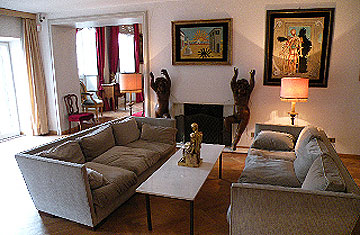
The house of the late Surrealist painter Giorgio de Chirico still retains an intimate, lived-in look
Rome is scattered with the most alluring ancient ruins in the world and more stashes of art masterpieces in its churches and palazzos than you can possibly appreciate even in several visits. Yet its history did not stop at the Renaissance, and some new and updated house museums provide intriguing wormholes into private Roman lives of more recent but equally fascinating eras. Everyone knows the best way to see a city is from the inside out, as a guest in the home of a friend, and here is a way to do it with no strings attached.
1. Casa Museo Alberto Moravia
The 1960s marked the heyday of modern Rome and Italian cinema, when la dolce vita was a reality and the city was buzzing with celebrities and artists, most famously frequenting Via Veneto (now sadly home only to luxury hotels and the Hard Rock Café). Opened last fall, the apartment where novelist and film critic Alberto Moravia lived his last thirty years wonderfully evokes the creative foment of Rome's Modernist era. In a 1930s building overlooking the Tiber River, it is decorated with paintings by key Italian artists of the time — such as the author's friends Mario Schifano and Renato Guttuso — along with a mask collection from his travels in Africa and Asia. Moravia shared the apartment with his second wife, writer Dacia Maraini, and later his even younger Spanish companion, Carmen Llera; the vast library includes books dedicated by intimates Robert Penn Warren, Saul Bellow, and Pier Paolo Pasolini, with whom he shared a beach house in Sabaudia. Moravia's own books speak of his biggest obsession: women. His novel Contempt was made into the classic film directed by Jean-Luc Godard and starring Brigitte Bardot. He died here in the bathroom while shaving one September morning in 1990. Lungotevere della Vittoria 1; fondoalbertomoravia.it
2. Museo Mario Praz
This satellite museum of the National Gallery of Modern Art opened to the public in 1995 and has remained unchanged since the death of its owner, in 1982. Praz, who was knighted by Queen Elizabeth, was a celebrated scholar of English literature (best known for The Romantic Agony, a book elaborating on the erotic and morbid themes of the Romantic authors) and a collector of nineteenth-century art. The meandering apartment is chock full of strange artifacts such as wax figures, period portraits, and precious objects like a dazzling micro-mosaic portraying an ancient gate of Milan in 1807. The first room is nearly identical in style to the salon portrayed in a painting of Queen Maria Isabella in her Neapolitan palace, which hangs on a wall; near the kitchen hangs a depiction of a kitchen interior at Florence's Palazzo Mozzi. Don't miss the charming view out back on Via Soldati, a quiet back street that seems to exist outside of time. Via Zanardelli 1; museopraz.beniculturali.it
3. The Keats Shelley House
Open for over 100 years, the Keats-Shelley house (of which Praz was chairman of the board) has just been expanded to include a new bookshop and memorabilia — as well as a period sleigh bed (Vatican law dictated burning of the original, believed to be TB-infected). The bedroom where the young Keats died — and his friend the artist Joseph Severn attended him — overlooks the Spanish Steps, then as now full of the cacophony of street vendors and loiterers accompanied by the soothing trickle of Bernini's marble boat fountain. Above the bed is the touching portrait of the poet on his deathbed painted by Severn in the next room, where an evocative life-mask cast years earlier by painter Benjamin Robert Haydon is displayed. The other rooms, including the former landlady's chambers, are full of correspondence and memorabilia related to Keats and writers Percy and Mary Shelley, as well as Lord Byron, who had stayed at number 66. The new director, Giuseppe Albano, organizes occasional literary readings, workshops, and concerts. Piazza di Spagna, keats-shelley-house.org
4. Giorgio de Chirico Casa Museo
This uncanny apartment evokes the sensation that the painter has just gone out for a stroll. In the spacious first-floor salons, slightly disheveled modern sofas and a vintage TV contrast with kitschy Louis XIV-style repros and zaftig cupids just as the varied canvases and sculptures from every stage of De Chirico's career (still lifes and portraits, depictions of classical mythology, and the better known Surrealist work) hang side by side. The ornate master bedroom upstairs was his wife Isabella's, while a tiny room with a single bed — but an enviable view of the Trinità del Monte — was where the artist slept. An antique typewriter placed on the desk by artist Olaf Nicolai invites visitors to inscribe their dreams (part of the yearlong contemporary art exhibition D'Après Giorgio). The enormous studio is especially full of life: objects used in the paintings, books that inspired, and the superstitious artist's good luck charms, such as a horseshoe hanging from the easel, are still all around. Piazza di Spagna 31; fondazionedechirico.org
